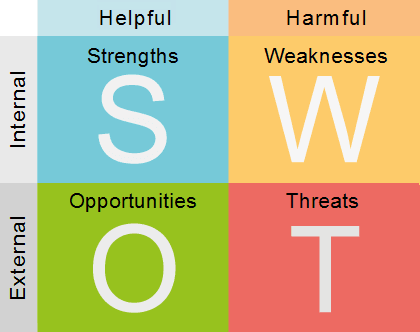How to Create a Small Business Marketing Plan in 10 Steps

I am sometimes flabbergasted by the number of small businesses who lack what is, in my opinion, the cornerstone document of any biz: a marketing plan. During the onboarding process at Idunn, I always ask clients about their marketing strategy. Irrespective of the service they contact us for.
Why?
Well, copywriting, social media management or content writing are all tools. Together, they shape (part of) a small business marketing plan. Which, in turn, has to serve business goals.
When clients contact us for marketing strategy services, I always ask about their current or previous ones. Finding out that something like this existed once is the exception, not the norm.
Yes, I know what you’re going to say:
If they’re still in business after years without a marketing plan, it means that it worked out for them.
That’s partially true.
91% of employees believe that their company will no longer be competitive by 2020 if it stays in its current form, says a recent study. So change is not only natural, but also welcome (or it should be).
In my experience of 10+ years in the marketing field, every worthwhile business endeavor starts with a plan. Or a strategy, a roadmap – call it what you will. Just be sure to have one in place.
The ten steps below are part of the blueprint we use in-house to create small business marketing plans for our customers.
10 Steps to Creating an Effective Small Business Marketing Plan
At Idunn, we have worked on short, long and medium term marketing plans for small businesses, startups and even government departments or corporations. Irrespective of the size of the organization and the length the plan has to cover, there are some cornerstone prerequisites it has to include.
-
Your Marketing Plan Has to Be Aligned with Your Business Goals
You would be surprised at how many people get this wrong. A lot of marketers view their department as a separate entity of the business. When it’s not.
In fact, Business Development, Sales and Marketing should always work closely together. And serve the same purpose – attaining business goals. Great marketing is not a goal in itself. It’s a means to an end. Typically, that end is extra revenue.
Which brings us to number two on our lists of steps towards the ideal small business marketing plan.
-
Set Clear, Quantifiable Goals
This is not just about marketing accountability – although that is very important, as well.
This is about making sure that your goals are aligned with your business’ goals. In other words, this is about letting go of vanity metrics and focusing on what really matters – marketing ROI.
For instance, you should never list “getting 1 million unique visitors to the website in the next year” as an objective. Instead, you can say something like: “getting 10 qualified leads per month through our website”.
If your research shows that you need 1 million users for that to happen, that’s great. Go ahead and come up with marketing tactics to get that traffic. But never consider it the ultimate goal.
Why, you ask?
Because 1 million visitors help no one. They bring no actual revenue. Again, they are a means to an end. Plus, you can easily “cheat” – invest in PPC ads for a very low-priced target audience and you can get 1 million users in less than a year. Will they be part of your target audience, though? Probably not.
So, instead of listing vanity metrics like traffic and followers/fans numbers, aim for real, tangible goals like:
- Increase sales by 20%
- Grow conversion rate by 15%
- Grow customer retention by 30%
-
Get to Know Your Target Audience in Detail
Create a buyer persona for your small business marketing plan and all the tactics listed in it. It won’t just make writing the plan easier, but also help you implement it with better results.
As I said in a recent blog post, great writing can only exist if you respect your reader. In turn, respecting your reader means writing something that responds to their wants and needs. And you can’t do that without knowing exactly what those wants and needs are and, ideally, where they stem from.
The same goes for any marketing tactic, not just writing.
In order to get all the details you need about your buyer persona, you need to act like a crisscross between a detective and a psychologist. Research is crucial, but so is empathizing with your buyer persona and understanding why their wants and needs haven’t been met yet.
Never leave out details about your persona(s). Everything matters. For example, you may be tempted to leave out food preferences if you’re selling B2B services. Why does it matter if your persona is a vegetarian if you’re not selling food?
Well, it can help you – an email subject line, a photo on social media, an analogy in your blog post, everything that speaks to them can be the drop that turns a reader into a lead or a customer. Yes, even for the B2B sector – behind every organization there are humans that you need to convince, not faceless execs.
-
Be Honest in Your Competition Analysis
This is another point that most small business marketing plans get completely wrong.
“Our competitors don’t know what they are doing.” “People only buy from our competitors because they’ve been tricked into it.” “It’s marketing’s job to make sure that our target audience knows who provides the real value.”
This is what transpires from most competition analyses. I know we all like to believe that we are better than our competitors. And, odds are, we are – at least in some respects. But we can’t be better than them from every point of view.
Being honest with yourself when researching and writing the competition analysis is the key to obtaining relevant data. And to putting it to good work.
Do your competitors have a better supply chain? Do they have better prices? Do they invest more in marketing? Are their products more frequently upgraded?
Answer all questions like these honestly and you will have a competitive landscape overview worthwhile. No one needs a dishonest pat on the back. What your company needs is revenue, which you can’t get by lying to yourself.
And, if you want to bash your competitors in your marketing plan, you can do so in the next section.
-
Create a Detailed SWOT Analysis
SWOT analysis may sound like it’s so last year, but you’ll be amazed at what can happen when you simply put Strengths, Weaknesses, Opportunities and Threats on paper.
 Image via Cornell.edu
Image via Cornell.edu
As the photo above depicts, strengths and weaknesses refer to your internal analysis, while opportunities and threats refer to what happens outside your business – things you typically can’t control.
For instance:
- Strength: our products have the best price in their class
- Weakness: our products haven’t been upgraded in two years
- Opportunity: there is increased demand for our products in the market
- Threat: increased taxes for our products
-
Find Your Unique Selling Proposition (USP)
Brevity is key here. If you can’t say it in a (short) phrase, then it’s not a unique selling proposition. It’s a sales pitch.
For example, M&M’s USP is: “Chocolate that melts in your mouth, not your hand.” It’s a great USP because it manages to convey a benefit and bash competitors – all within less than 190 words.
-
Identify Marketing Tactics (and Avoid Spreading Yourself too Thin)
I know, it’s a pain to have to choose between the countless marketing channels at your disposal (I wrote an article on how to choose the right digital marketing channels, by the way). And most marketers make the mistake of trying to be everywhere.
From PPC ads to events and blogging, we are wired to want a piece of everything. Yes, we can reap some benefits from a lot of marketing channels (both traditional and non-traditional ones). And, if you have an unlimited budget and a team of 100+ people, freelancers and agencies, go ahead, try them all.
But if that is not your case, you might want to choose wisely and mercilessly.
Irrespective of your budget, odds are you won’t be able to keep up with all the marketing tactics you’d like to try. In fact, I even advise clients who come for us for social media management and marketing services to stick to a few networks. Ideally, less than four of them.
You want to have a coherent brand presence on all your channels – online and offline. And you can’t do that without “winging it”.
Thus, it’s better to stick to a few tactics and really master them. Social media, email marketing, events, PR, blogging, white papers, webinars, content marketing, SEO, PPC – I could go on forever.
Again, the best way to choose between channels and tactics is to go back to your business goals. Which of these tactics can serve your business goals better – both in the long and in the short run?
-
Create a Detailed Budget
This one is pretty straightforward. Your small business marketing plan needs a budget that is clear for both the business owners and your department. A spreadsheet that you can update constantly is ideal.
I also advise my clients to have a “back-up sum” for unforeseen events. Nothing huge – say 5% to 10% of your entire budget. This way, you can easily act if a new opportunity presents itself. In my experience, you will end up spending those money on additional copywriting services, on a new must-attend event or on upping your PPC budget to make sure you reach your budget.
-
Don’t Forget About Metrics and Evaluation
At the end of the time frame covered by your small business marketing plan, you will have to evaluate it. This is not just something you do for your bosses, it’s first and foremost useful within the marketing department.
You can always correlate this with business indicators (increase of sales, for instance). Also, make sure that you have tools like Google Analytics in place to track conversions – you want to know which of your content efforts yielded the best results.
From Facebook’s pixel and Google’s UTM links to an old-school notebook that you use to jolt down people you meet at an in-person event, everything will help you plan better for next year (or the next time frame). Of course, it also helps with marketing accountability.
-
Give a Sneak Peek into Next Year’s Strategy
This step is ideal if you create a small business marketing plan that upper management has to approve first. Give them an idea of how you see the business booming after your great strategy is in place. Couple your ideas with market forecasts and industry trends.
Also, give options: increase in budget allocated to content marketing if X results are met, brand presence on a new social media network when the three ones we currently use don’t yield expected results, more focus on marketing automation – all these are perfect examples that convey the fact you are focused on scalability and confident in your efforts. And, at the same time, that you have a realistic and flexible approach.
Want to hire an external marketing strategist that can incorporate all the points above (and many others) into your own winning strategy? Your revenue-boosting small business marketing plan is just a contact form away:


2 Comentarii la “How to Create a Small Business Marketing Plan in 10 Steps”
Great post! Good strategy is the first step to grow your business. I’m really happy that there are strategies for marketing automation, because it’s a great way to boost your business. We’re currently using GetResponse.
[…] what is a marketing plan without a budget to sustain […]